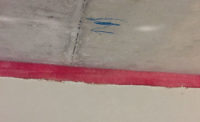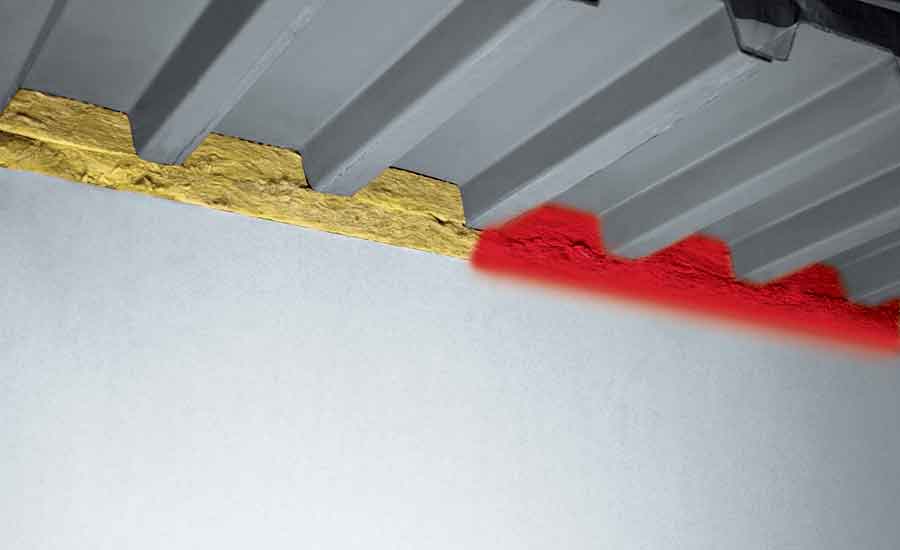The concept is basic; impede the passage of fire, smoke and toxic gases from one side of a fire-rated assembly to another using an installed firestopping system which limits amount of damaged caused by fire and protects building occupants and property. These systems include firestop products, backing materials, building materials of the wall and floors and the specific instructions for how it is all installed. Applications such as pipes or cables passing through a rated wall or floor, and the intersection of two rated wall/floor assemblies are examples of common conditions encountered every day. It is critical to maintain the fire-rating of the assemblies while allowing for the penetrants to move throughout the building or the assemblies to intersect.
For the interior finishing professional, a common application is the head of wall (or top-of-wall), where a fire-rated wall ascends to the underside of a rated floor assembly above. This intersection is critical in the aspect of fire protection as it creates the boundaries of these compartments, while also providing for movement of the floor above. This movement is caused by numerous factors such as dynamic loads, wind and thermal expansion or contraction, just to name a few.
System Testing of the Head-of-Wall Joint Condition
Firestop systems are tested according to defined UL or ASTM standards by third party testing agencies to verify the performance of the entire assembly. Head-of-wall conditions are tested to Underwriters Laboratories Standard 2079; Standard for Tests for Fire Resistance of Building Joint Systems. This testing is “applicable to joint systems of various materials and construction that are intended for use in linear openings between adjacent fire resistive structures.” The testing consists of various parts to evaluate the integrity of the firestop system design. These include:
- The joint system being subjected to a standard fire exposure controlled to achieve specified temperatures over time.
- Subjecting a load bearing assembly to the specified design load for the intended use, if applicable.
- Cycling joint systems a defined number of times through the intended range of movement and locked into the largest width before being exposed to fire.
- Subjecting head-of wall systems to a hose stream test after exposure to fire conditions.
In order for this application system to be considered a successful test, the transmission through the joint system of heat and gases cannot be enough to ignite cotton waste on the non-fire side. Rather than using cotton waste, this criteria is evaluated by monitoring the temperature of the non-fire side of the system, with a limit of 325 degrees Fahrenheit above the ambient air temperature. Once the measuring thermocouple on the non-fire side reaches this target temperature (for example: 400 degrees if the test specimen measures 75 degree at the start of the test), then the fire test is stopped and the system subjected to the impact of the hose stream test. Assuming adequate performance of the system, it is assigned an “assembly” rating: either one or two hours.
Changes to the Testing Standard
Recently, UL has released a change to the 2079 testing criteria (dated August 26, 2015), that may have an impact on the rating currently assigned to top-of-wall systems. The changes in the standard include two basic points:
- Modified verbiage regarding the placement of thermocouples and;
- Allowances to modify the thermocouple mounting pad to fit snugly over top of joints for joints smaller than 2 inches.
Prior to the changes, thermocouples were placed over the head-of-wall joint flush with the outside layer of gypsum. This resulted in a gap between the thermocouple and the firestopping materials in systems utilizing a recessed solution. The above modifications to UL 2079 will eliminate this gap, potentially affecting the temperature readings on the non-fire side of the system, which may in turn affect the system’s assembly rating. Going forward third party listing agencies are expected to reevaluate all top-of-wall systems to determine what systems need to be retested.
Any system not meeting new requirements will have their rating modified or be removed from the system directory.
Path Forward
Timing for implementing changes to the UL 2079 standard is typically two years. This time allows manufacturers to reevaluate their product and application solutions. If minor modifications to the system can be made within the new testing protocol, these changes are made and then retested. Other times, significant redesign of the system may be required. These changes can involve new materials required in the installation process or a change in the wall systems tested and approved for use. In some cases they require products and systems to be removed from the system directory when no solution can be found.
While always important that the interior finishing contractor understands the status of their current firestopping method, this change in UL 2079 will require special attention when addressing the head-of-wall solution. In the future products, systems and installation procedures will likely start to change. The installer can best understand and keep track on the ongoing process by following a few simple steps:
- Contact the firestop manufacturer or distributor before installing a system.
- Review manufacturer Web sites for third party listed system information related to the changed standard.
- Review third party listed system details of proposed head-of-wall solutions.
- Schedule and attend local training seminars performed by the firestop manufacturers dedicated to the head-of-wall firestop application.
By staying current with the latest firestopping test standards, construction professionals play an integral role in protecting building occupants and property which impacts overall life safety.

















